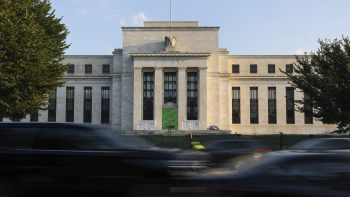The future of low-cost borrowing
Share Now on:
The future of low-cost borrowing
Kai Ryssdal: The yield on 10-year Treasury notes today — that’s the interest rate the government’s paying — closed just under 2 percent, 1.93 to be precise, which is unbelievably low. That’s great for the Treasury Department, not so great for banks trying to make money or regular people trying to get anything out of their savings. In fact, the rate’s so low that once you adjust for inflation some investors are essentially paying to lend money to the government. Negative real interest rates is the technical term. Binyamin Appelbaum writes about low low interest rates in the New York Times today.
Binyamin Appelbaum: Good to be with you.
Ryssdal: So we need to set something up right at the start here because this is kind of a complex story, but what’s going on in the bond markets right now is that the American government is effectively borrowing money for nothing. Right?
Appelbaum: Yeah. The government’s the world’s biggest buyer and right now it’s doing it free of charge, basically.
Ryssdal: How come? What gives? And how do I get some of that?
Appelbaum: Well, you know, you can’t. But for them, there’s a bunch of good things going on. One is that other governments that are looking for a place to put their money are sending it to the United States. In fact, they’re so desperate to get it into the door that they’re basically offering the government at interest rates that effectively mean they’ll lose money over the course of the loan. Another fact — the Federal Reserve is pushing down hard on interest rates, so across the board the rates are very low. There’s not a lot of good alternative places to put your money to make a higher rate of return. And the economy is still pretty lousy, so investors are looking around and thinking maybe a little loss is better than larger one.
Ryssdal: Skeptics out there will say, ‘You know what, this can’t last forever. Low interest rates have been around for a while and we’re going to get slammed.’ When’s that going to happen?
Appelbaum: Well I think not just skeptics, but almost everyone agrees that it can’t last forever. The question is how much longer. When it turns, it could turn dramatically. It might not be the case that interest rates start to inch up. It might be the case that they jump really sharply, and that could be a really big deal for the government’s finances. Right now the government is paying exactly as much in interest as it did five years ago — even as the size of the debt has effectively doubled.
Ryssdal: Say that again: We’re paying the same amount in interest on our debt as we were five years ago?
Appelbaum: The government’s interest bill in 2011 was almost exactly the same as in 2006 — even though the size of the debt was twice as large.
Ryssdal: And then what happens though?
Appelbaum: Effectively right now we’re getting a half-off sale. The government is paying 50 percent of what it might under normal circumstances. You could imagine very easily that the sale ends, the cost of financing that debt is twice as high, the deficit is significantly larger, and these financial problems that we keep on talking about somewhere out in the future — where the government will run out of money to finance all of its obligations — all of a sudden that becomes much more imminent.
Ryssdal: Is that the reason the Treasury Department is not just shoveling 10-year T-Notes out the door and borrowing as much as it can right now because it fears that quick turnaround?
Appelbaum: It’s complicated. One reason that they’re not doing it is that the Federal Reserve is right now trying to hold down long-term interest rates by reducing the availability of long-term notes in the marketplace. So if the Treasury started printing long-term notes, it would effectively negate the effect of the Fed’s efforts. So there’s a real strain there. It’s basically there is a certain amount of goodness there and you can either take it now or you can take it in the long term. Treasury is resisting the temptation to take it in the long term so that we can get more of it now when the economy needs it.
Ryssdal: And in theory when the rest of us need it too, right? Not just the economy, but everybody out there who does in some measure benefit from these low rates.
Appelbaum: We are the economy, Kai. Each and every one of us.
Ryssdal: Binyamin Appelbaum is a reporter for the New York Times. Hey Binyamin, thanks a lot.
Appelbaum: My pleasure.
There’s a lot happening in the world. Through it all, Marketplace is here for you.
You rely on Marketplace to break down the world’s events and tell you how it affects you in a fact-based, approachable way. We rely on your financial support to keep making that possible.
Your donation today powers the independent journalism that you rely on. For just $5/month, you can help sustain Marketplace so we can keep reporting on the things that matter to you.


















